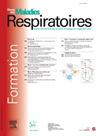Effect of repetitive magnetic stimulation on respiratory function after cervical spinal cord injury
IF 0.5
4区 医学
Q4 RESPIRATORY SYSTEM
引用次数: 0
Abstract
Introduction
Traumatic cervical spinal cord injuries (cSCI) damage respiratory pathways leading to life-threatening respiratory insufficiency. Inflammation is known to play a role in limiting neural regeneration after injury, thereby exacerbating respiratory dysfunction and refrain respiratory recovery. Repetitive Magnetic Stimulation (rMS) has emerged as a promising therapeutic intervention in SCI, demonstrating potential in reducing inflammation at the spinal level. In this project, we aim to explore the therapeutic potential of rMS in enhancing respiratory function by attenuating neuro-inflammation in a mouse cervical hemi-contusion (HC) model, which closely mimics the pathophysiology of human cSCI.
Methods
Eighteen adult Swiss male mice underwent hemi-contusion at the C3-C5 level (C3HC, n = 15) or laminectomy (n = 3) and received either high-frequency (10 Hz) rMS or sham treatment for 10 days (9 trains of 100 biphasic pulses, separated by 30 s intervals between trains delivered at 80% MO (percentage of maximum output of the stimulator), 900 stimulations per protocol). Animals that showed a reduction of more than 20% from baseline were divided into two groups: (1) C3HC + sham rMS (n = 5); (2) C3HC + rMS (n = 6). Respiratory function was assessed using whole-body plethysmography before (Day 0) and after C3HC (Day 7) and after intervention (Day 21) and provide amplitude (tidal volume, VT) and respiratory frequency (fR). Moreover, diaphragm activity was measured by in-situ electromyography (EMG). All spinal cord samples were collected for Immunofluorescence experiments.
Results
In the whole group of mice, SCI led to a mean decrease in VT of 37% without differences between groups. Mice which received rMS, exhibited a recovery in VT greater than spontaneous recovery as measured in the sham rMS group and there was a trend to significant difference between groups (rMS: D21vs. D7: 6.5 ± 1.1 μL/g vs. 4.1 ± 1.2 μL/g, sham rMS: D21vs. D7: 4.5 ± 0.5 μL/g vs. 3.3 ± 1.3 μL/g, 2 ways RM ANOVA, p = 0.05). There was no significant change observed for fR. As a result, similar changes were observed for VE than VT after rMS or Sham but differences between groups were not significant. In addition, at D21, the activity of the ipsilateral (injured side) hemidiaphragm tended to be lower than control values (Laminectomy) but only in the sham group, for both ventral and medial hemidiaphragms (Ventral: sham rMS vs. lami: 5.0 ± 1.4 vs. 7.3 ± 1.5 A. U., P = 0.09, Medial: sham rMS vs. lami: 4.7 ± 2.4 vs. 8.9 ± 3.3 A. U., P = 0.06). No differences were found with baseline in the rMS group, suggesting that hemidiaphragm EMG activity may have recovered faster in this group. No differences were found in this contralateral side.
Conclusion
Although preliminary, our results showed that rMS improved respiratory recovery after C3/4HC in mice and particularly tidal volume. The reduction in EMG activity that tended to be only present in the sham group would suggest that increased activation and/or excitability of phrenic nerve is one mechanism induced by rMS. However, this finding needs to be confirmed with a greater number of animals. Moreover, neuroinflammation at the spinal cord level (astrocyte, macrophage, microglia, and chondroitin sulfate proteoglycan) will be analyzed and correlations with changes in respiratory variables will be investigated in regard to treatment groups.
重复磁刺激对颈脊髓损伤后呼吸功能的影响
外伤性颈脊髓损伤(cSCI)损害呼吸通路,导致危及生命的呼吸功能不全。已知炎症在限制损伤后神经再生中起作用,从而加剧呼吸功能障碍并抑制呼吸恢复。重复性磁刺激(rMS)已成为一种有希望的脊髓损伤治疗干预措施,显示出减少脊髓水平炎症的潜力。在本项目中,我们旨在探索rMS通过减轻小鼠颈半挫伤(HC)模型的神经炎症来增强呼吸功能的治疗潜力,该模型与人类cSCI的病理生理非常相似。方法18只成年瑞士雄性小鼠在C3-C5水平(C3HC, n = 15)或椎板切除术(n = 3),接受10天的高频(10 Hz) rMS或假治疗(9组100双相脉冲,每组间隔30秒,以80% MO(刺激器最大输出百分比)传递,每个方案900次刺激)。较基线减少20%以上的动物分为两组:(1)C3HC +假rMS (n = 5);(2) C3HC + rMS (n = 6)。在C3HC前(第0天)、C3HC后(第7天)和干预后(第21天)使用全身容积描记术评估呼吸功能,并提供幅度(潮气量、VT)和呼吸频率(fR)。此外,通过原位肌电图(EMG)测量膈肌活动。采集所有脊髓标本进行免疫荧光实验。结果在全组小鼠中,脊髓损伤导致VT平均下降37%,组间无差异。在假rMS组中,接受rMS的小鼠VT的恢复大于自发恢复,并且两组之间有显著差异的趋势(rMS: D21vs.)。D7: 6.5±1.1μL / g和4.1±1.2μL / g,虚假的rMS: D21vs。D7: 4.5±0.5μL / g和3.3±1.3μL / g, 2方法RM方差分析,p = 0.05)。fR未见明显变化。因此,rMS或Sham后VE的变化与VT相似,但组间差异不显著。此外,在D21时,同侧(损伤侧)半膈的活动倾向于低于对照组(椎板切除术),但仅在假手术组,腹侧半膈和内侧半膈(腹侧:假手术:5.0±1.4 vs.椎板:7.3±1.5 A)。U P = 0.09,内侧:虚假的rMS与lami: 4.7±2.4和8.9±3.3。U, p = 0.06)。rMS组与基线无差异,提示该组半膈肌电活动恢复得更快。对侧未见差异。结论虽然是初步的,但我们的结果表明,rMS改善了小鼠C3/4HC后的呼吸恢复,特别是潮气量。肌电图活动的减少似乎只出现在假手术组,这表明膈神经激活和/或兴奋性的增加是rMS诱导的一种机制。然而,这一发现需要在更多的动物身上得到证实。此外,将分析脊髓水平的神经炎症(星形胶质细胞、巨噬细胞、小胶质细胞和硫酸软骨素蛋白多糖),并研究治疗组呼吸变量变化的相关性。
本文章由计算机程序翻译,如有差异,请以英文原文为准。
求助全文
约1分钟内获得全文
求助全文
来源期刊

Revue des maladies respiratoires
医学-呼吸系统
CiteScore
1.10
自引率
16.70%
发文量
168
审稿时长
4-8 weeks
期刊介绍:
La Revue des Maladies Respiratoires est l''organe officiel d''expression scientifique de la Société de Pneumologie de Langue Française (SPLF). Il s''agit d''un média professionnel francophone, à vocation internationale et accessible ici.
La Revue des Maladies Respiratoires est un outil de formation professionnelle post-universitaire pour l''ensemble de la communauté pneumologique francophone. Elle publie sur son site différentes variétés d''articles scientifiques concernant la Pneumologie :
- Editoriaux,
- Articles originaux,
- Revues générales,
- Articles de synthèses,
- Recommandations d''experts et textes de consensus,
- Séries thématiques,
- Cas cliniques,
- Articles « images et diagnostics »,
- Fiches techniques,
- Lettres à la rédaction.
 求助内容:
求助内容: 应助结果提醒方式:
应助结果提醒方式:


